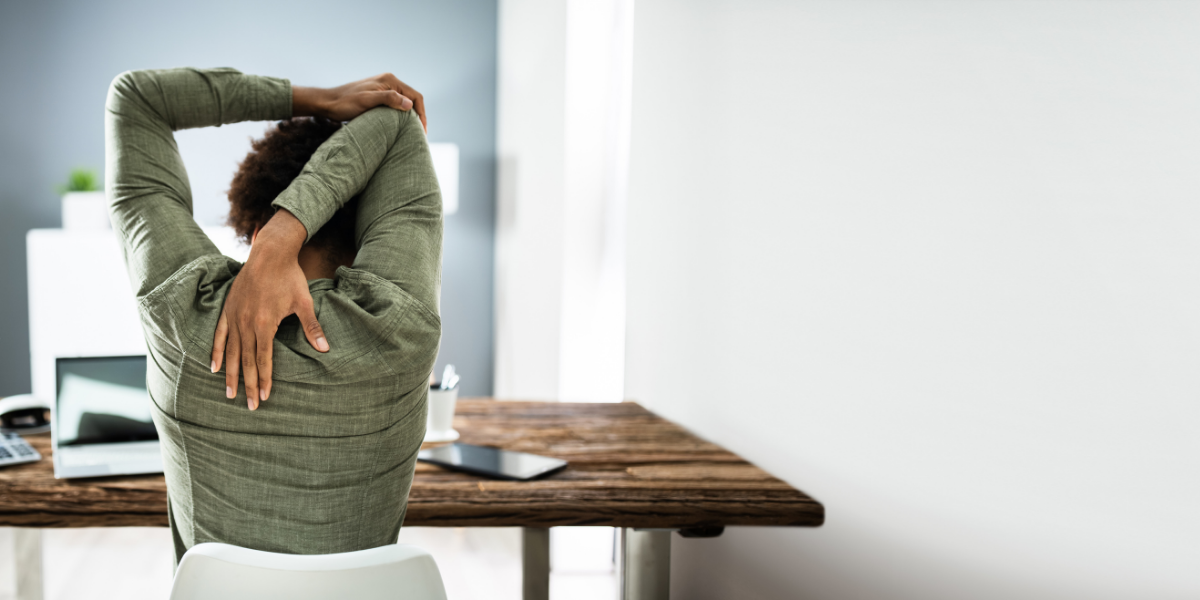As more professionals find themselves tethered to desks for extended periods, there’s a rising awareness about the importance of interspersing moments of activity during the workday. Recognising and acting on the need for desk exercises can counteract these health concerns and boost productivity and well-being during the workday.
This article highlights the best desk exercises and their benefits and provides a practical guide for integrating them seamlessly into the daily routine.
Table of Contents
The Need for Best Desk Exercises
While the digital age has its conveniences, it also introduces new challenges for maintaining health and wellness. Among these challenges, one of the most critical is the passive nature of modern work. The best desk exercises offer a practical solution to this growing concern, promoting movement and flexibility even within the confines of the office cubicle.
Health Risks of Prolonged Sitting
“We see a sharp increase in musculoskeletal problems among individuals who have desk-bound jobs. The correlation between prolonged sitting and back pain or posture issues is alarmingly high,” notes Dr Robert Lawson, an orthopaedic surgeon. Prolonged sitting can lead to a range of both short-term and long-term health risks:
- Poor Posture and Musculoskeletal Problems
Extended periods of sitting, especially when using a computer, can lead to slouching and poor posture. This can result in musculoskeletal problems, including back pain, neck pain, and repetitive strain injuries.
- Cardiovascular Disease
Sedentary behaviour is linked to increased heart disease and stroke risk. The lack of physical activity can contribute to the buildup of fatty acids in the arteries, leading to cardiovascular problems.
- Obesity and Metabolic Syndrome
Sitting for long hours can lead to weight gain and associated health problems, including metabolic syndrome. Research from the Diabetes Care journal indicates prolonged sitting increases the risk of developing type 2 diabetes.
- Mental Health Issues
Physical inactivity also increases the risk of mental health disorders like depression and anxiety. A British Journal of Sports Medicine meta-analysis found that sedentary behaviour is associated with an increased risk of depression.
Benefits of Incorporating Movement Throughout the Workday
“Short, frequent breaks that involve physical movement can dramatically improve blood circulation and cognitive function,” shares neuroscientist Dr Jacob Raber. Incorporating desk exercises into your daily routine can yield numerous benefits:
- Improved Physical Health
Regular movement helps improve cardiovascular health, aids in weight management, and reduces the risk of chronic diseases.
- Better Posture and Reduced Pain
Best desk exercises can strengthen the muscles that support good posture, reducing the likelihood of back and neck pain.
- Increased Productivity
Even in short bursts, physical activity can help increase focus and productivity by promoting better blood flow and oxygenation to the brain.
- Boosted Mood
“The release of endorphins during any form of exercise, even short desk exercises, can greatly uplift mood and alleviate feelings of stress,” adds Dr Maria Guerrero, a psychiatrist.
- Reduced Stress
Active breaks can relieve stress, helping break the work-related tension and anxiety cycle.
Best Desk Exercises
There’s a solution that doesn’t involve leaving your desk – best desk exercises. These simple yet effective movements can help mitigate the negative impacts of prolonged sitting, boost your energy levels, and enhance overall wellness. The following are some of the best desk exercises designated to different body parts for a healthier, more active lifestyle.
Upper Body
The best desk exercises for the upper body are simple, require no special equipment, and can be done right from your desk chair. They target areas most affected by desk work, including the shoulders, arms, chest, and wrists.
1. Shoulder Shrugs
Among the best desk exercises, this one involves a simple upward movement of the shoulders, similar to a shrugging gesture. It’s designed to relieve tension in the upper trapezius muscles, commonly affected by desk work.
Step-by-Step Guide:
- Sit upright in your chair.
- Keep your arms relaxed at your sides.
- Lift your shoulders towards your ears as high as you can.
- Lower them back down in a controlled motion.
2. Arm Circles
As the name suggests, this exercise engages the shoulders in small circular motions. It’s a great way to improve shoulder mobility, offsetting the limitations imposed by long periods of sitting.
Step-by-Step Guide:
- Extend your arms out to the sides at shoulder height.
- Start by making small circular motions forward for 10-15 seconds.
- Reverse the direction, making small circles backwards for another 10-15 seconds.
- Gradually increase the circle size for added stretch.
3. Desk Push-Ups
A variation of the traditional push-up, this exercise, which is also among the best desk exercises, uses the edge of a desk instead of the floor. It targets the arms, chest, and shoulders, enhancing upper body strength without leaving the workspace.
Step-by-Step Guide:
- Stand a couple of feet away from your desk.
- Place your hands on the edge of the desk slightly wider than shoulder width.
- Lower your body towards the desk by bending your elbows.
- Push yourself back to the starting position.
- Perform 10-15 repetitions.
4. Hand Clasps Behind Back
This exercise involves clasping the hands behind the back and lifting them upwards. It opens the chest and stretches the front shoulder muscles, counteracting the hunched posture often adopted during desk work.
Step-by-Step Guide:
- Sit or stand tall.
- Clasp your hands behind your back, keeping your arms straight.
- Gently lift your arms upward and hold for 15-20 seconds.
- Release and repeat 2-3 times.
5. Wrist Flexor and Extensor Stretches
This series of stretches, classified under the best desk exercises, focuses on the wrist flexors and extensors. It’s an excellent way to alleviate wrist strain, a common issue among computer users, by promoting flexibility and circulation in the wrist and forearm.
Step-by-Step Guide:
- Extend one arm out in front of you with the palm up.
- Using the other hand, gently pull the fingers of the outstretched hand towards you. Hold for 10-15 seconds.
- Now turn the outstretched palm facing down. Using the other hand, gently press down on the back of the outstretched hand to stretch the wrist’s top. Hold for 10-15 seconds.
- Repeat with the other wrist.
Core and Back
Maintaining core and back strength is crucial, particularly when working in a seated position for extended periods. Here are some of the best desk exercises to engage, strengthen, and stretch your core and back muscles.
1. Seated Twists
Among the best desk exercises, seated twists involve rotating your upper body from the waist while seated, providing a gentle stretch that engages the obliques and improves spinal flexibility.
Step-by-Step Guide:
- Sit tall on your chair, feet flat on the ground.
- Place your left hand on your right knee.
- Gently twist your torso to the right, using your right arm to grip the back of the chair for support.
- Hold for a few breaths, then switch sides.
2. Chair Planks
Chair planks are a modified version of the traditional plank exercise performed with your hands on the seat of a sturdy chair. This exercise targets the entire core, helping to strengthen these central muscles.
Step-by-Step Guide:
- Stand facing the chair and place your hands on the seat.
- Walk your feet back until your body is straight from head to heels.
- Engage your core and hold for 20-30 seconds, ensuring your back doesn’t sag.
3. Back Extensions
Back extensions, one of the best desk exercises, involve a simple forward and backward movement of the upper torso, fortifying the lower back, an area often neglected during desk work.
Step-by-Step Guide:
- Sit on the edge of your chair with your feet flat on the ground.
- Place your hands on the small of your back.
- Gently arch your back, looking slightly upwards.
- Hold for a few breaths, then return to the starting position.
4. Seated Pelvic Tilts
This exercise involves a small tilting movement of the pelvis while seated. It engages the deep core muscles and aids in maintaining good posture.
Step-by-Step Guide:
- Sit tall on your chair with your feet flat on the ground.
- Place your hands on your hips.
- Tilt your pelvis forward and backwards, feeling your lower spine’s movement.
- Repeat this motion 10-15 times.
5. Lateral Side Bends
Lateral side bends are part of the best desk exercises group, involving bending your torso from side to side. This exercise provides a good stretch while strengthening the oblique muscles.
Step-by-Step Guide:
- Sit or stand tall with your arms by your side.
- Raise one arm overhead and bend your torso to the opposite side.
- Hold for a few breaths, feeling the stretch along the side of your body.
- Return to the centre and repeat on the other side.
Lower Body
While prolonged sitting can lead to lower body discomfort and stiffness, there are effective ways to counteract these effects from your chair, like the best desk exercises. Here are some of the best desk exercises designed specifically for your lower body, targeting the legs, ankles, and glutes.
1. Seated Leg Lifts
Seated leg lifts involve raising your legs while seated, providing an excellent way to fortify your quadriceps without standing up.
Step-by-Step Guide:
- Sit up straight in your chair.
- Keeping one foot on the ground, lift the other leg straight before you.
- Hold for a few seconds, then lower back down.
- Repeat 10-15 times on each leg.
2. Foot Tapping
Foot tapping, recognised as one of the best desk exercises, is as simple as it sounds. By rapidly tapping your feet on the ground, you can help increase circulation in your legs, offsetting the effects of prolonged sitting.
Step-by-Step Guide:
- While seated, rapidly tap your feet on the floor as if running in place.
- Continue for 30-60 seconds.
3. Ankle Circles
This exercise involves circling your ankles while seated. Ankle circles are great for enhancing ankle mobility and can relieve potential stiffness due to lack of movement.
Step-by-Step Guide:
- Extend one leg out in front of you.
- Rotate the ankle clockwise for 10-15 circles.
- Switch directions and rotate counterclockwise.
- Repeat with the other ankle.
4. Seated Glute Squeezes
Seated glute squeezes, among the best desk exercises, are a discrete way to engage your glutes without needing to stand up. This exercise can help counteract the effects of sitting for extended periods, such as glutaeal muscle atrophy.
Step-by-Step Guide:
- While seated, squeeze your buttocks muscles together tightly.
- Hold for a few seconds, then release.
- Repeat 10-15 times.
5. Calf Raises
Calf can be performed while standing next to your desk. They strengthen the calf muscles and enhance lower leg circulation, making them a good countermeasure to prolonged sitting.
Step-by-Step Guide:
- Stand behind your chair, holding onto it for support.
- Lift your heels off the ground, rising onto the balls of your feet.
- Lower your heels back down.
- Repeat 10-15 times.
Movement Matters
It’s easy to overlook the health consequences of prolonged sitting and the passive nature of desk jobs. However, integrating the best desk exercises into your daily routine can significantly enhance your well-being and mitigate the risks of being desk-bound. Such exercises are not merely a momentary escape from work but an essential investment in one’s health. Everyone deserves to work in a way that sustains, rather than drains, their health.

